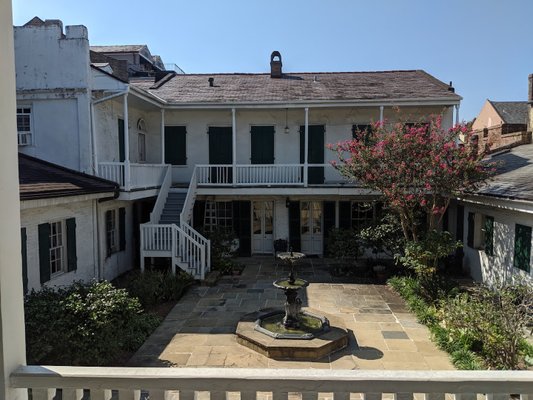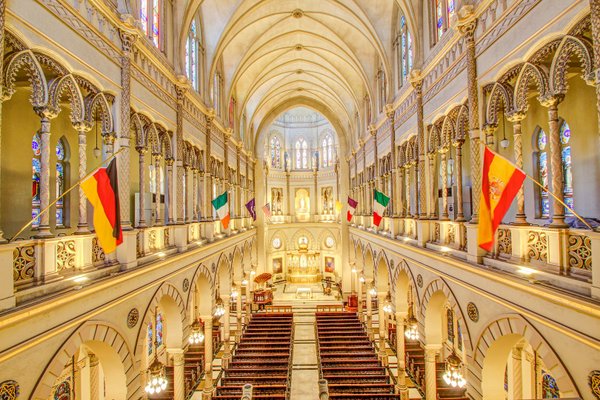Mentioned by Curbed New Orleans
Here are 10 museums you should visit in the French Quarter





"Located on the corner of North Rampart Street, the Our Lady of Guadalupe Church is the oldest house of worship in New Orleans. Originally named the Mortuary Chapel of St. Anthony of Padua, the place of worship was built in 1826 to serve as a burial church for the victims of yellow fever. The current name of the church was received in 1918."
"If you’re down in the CBD or headed toward the French Quarter, one small church lies hidden on Rampart Street. Peering through the doors, you see a rather simple sanctuary and some of the homeless asleep on the pews. The real beauty is to either side of the altar: the shrines to St. Jude and Our Lady of Guadalupe."


"The Beauregard-Keyes House is significant and worth a tour for its Greek Revival architecture, lovely quaint garden, and for once having been the residence of Confederate General Pierre Gustave Toutant Beauregard, a New Orleans native who ordered the first shots of the Civil War and remained a hero in the South long after the war was lost. Ursuline nuns used the property from the early 1700s until the 1820s when the new house was designed to combine elements of a Creole cottage with Greek Revival features, including a Palladian facade, curved twin staircases, Tuscan portico, and generous dining room. In 1945, author Frances Parkinson Keyes was looking for a place to write and live in New Orleans."
"The Beauregard -Keyes House museum includes past residents such as Confederate General Pierre Gustave Toutant Beauregard and American author Frances Parkinson Keyes. The house has elements of a Creole cottage with Greek Revival features, including a Palladian façade. It also has twin curved staircases leading to a Tuscan portico."

"Tours run twice every evening (5pm and 8pm) and include visits to the Lalaurie Mansion (where American Horror Story Coven was filmed), LaFitte’s Blacksmith Shop, and more. Our guide had plenty of creepy tales to share and clearly believed a lot of the ghost stories herself, which made it all the more fun. Our tour group was a little on the larger side, but otherwise, the experience was entertaining."
"Wander down to Governor Nicholls Street to see Lalaurie Mansion, once the home of actor Nicholas Cage, and one of the homes used for American Horror Story Coven. There are also other fancy homes like the New Orleans home of Angelina Jolie down this beautiful street."



"The French Market is a six-block-long bustling, open-air shopping center that can hold as many as 220 vendors on a busy day. You can shop for local art, t-shirts and hats and all things Mardi Gras while enjoying New Orleans street music and the aroma of fresh gumbo and jambalaya from the food stalls. The market has a ton of history, having existed on the same piece of land for more than 200 years."
"The French Market is a bustling, open-air shopping center that can hold up over 220 vendors on a given day. You can shop for paintings, clothing and specialty items while enjoying the famous New Orleans street music and smells of fresh gumbo and jambalaya. The market has a ton of history, having existed on the same piece of land for more than 200 years."
"Address: 700-1010 Decatur StreetNew Orleans, LA 70130Phone: (504) 636-6400Website. French Market is a popular open-air market and food hall in New Orleans. The space has permanent food stalls serving local étouffée, char-broiled oysters, crawfish, and more."


"It’s a stretch of road spanning three blocks located in the famous Faubourg Marigny in New Orleans. It has a reputation for being a must-do for music lovers thanks to its unofficial status as the greatest location in the city for live music. As you stroll through the street, you’ll be treated to the sight of delightfully cultural shops, charming old-fashioned cottages of a Creole style, and all the fun of a standard tourist location without the crowded state of Bourbon Street."
"Located on the edge of the French Quarter, in the Marigny neighbourhood, Frenchmen Street is a popular destination for live music and entertainment to enjoy. Here, you’ll find everything from; jazz, rock, blues, Latin, funk, zydeco, brass bands, and even EDM can be found here. Plus, you’ll easily find plenty of bars, clubs, and restaurants to spend a weekend at."
"The three-block stretch closest to the French Quarter is where it's at—complete with cafés, bars, and music clubs. The true magic…"

"After voodoo (or vodou) came to New Orleans in the 1700s—first via West African slaves, then with Haitians after the Haitian Revolution—it entwined with the city’s identity. Which is why, since the 1970s, a French Quarter visit has been deemed incomplete without a stop at the tiny Historic Voodoo Museum. If it’s lore you seek, you’ll find it here."


"A most intriguing New Orleans attraction, the Historic Voodoo Museum is surrounded with its fair share of lore, intrigue and notoriety. Located in the heart of the French Quarter, this unusual museum's flexible hours and affordable admission prices make it a must-see, even for skeptics. The dim halls are filled with antique altars, African artifacts used in the practice of this religion and works of art, allowing visitors an enlightened look at an interesting, often misunderstood, aspect of New Orleans culture."
"It has been described as “one of the most unique and interesting small museums in the country.” The New Orleans Voodoo Museum explores the history and culture of voodoo religion and its connection to New Orleans. Museum and cemetery tours as well as readers and practitioners are available."
"This museum has art, relics, and document that track the development of Voodoo in the city. Officials at the museum lead a Voodoo-based cemetery tour in the city, too. A post shared by Andrea Morleo (@andreamorleo82) on May 8, 2018 at 9:18pm PDT"

"Built in 1851 by the Jesuits, this breathtaking, Moorish-inspired structure melds Islamic architecture with Christian and Jewish symbolism (including hundreds of Stars of David). Massive bronze doors, soaring Arabesque arches, stunning stained glass (featuring 18 stations of the cross), cast-iron pews and columns are among the church’s many architectural highlights. Of special note is the towering cupola, the marble statue of Mary (originally carved for Marie Amélie, queen of Louis Philippe of France, during the mid 1800s) located above the onion-domed high altar and two Venetian-glass mosaic shrines at the rear of the sanctuary."
"Immaculate Conception church, locally known as Jesuit church, is a Roman Catholic church in the Central Business District of New Orleans. The original church was built on this site in 1857. Immaculate Conception church was built and designed in the Neo-Venetian Gothic style of Gothic Revival architecture, with Moorish Revival and Byzantine Revival elements."


























































